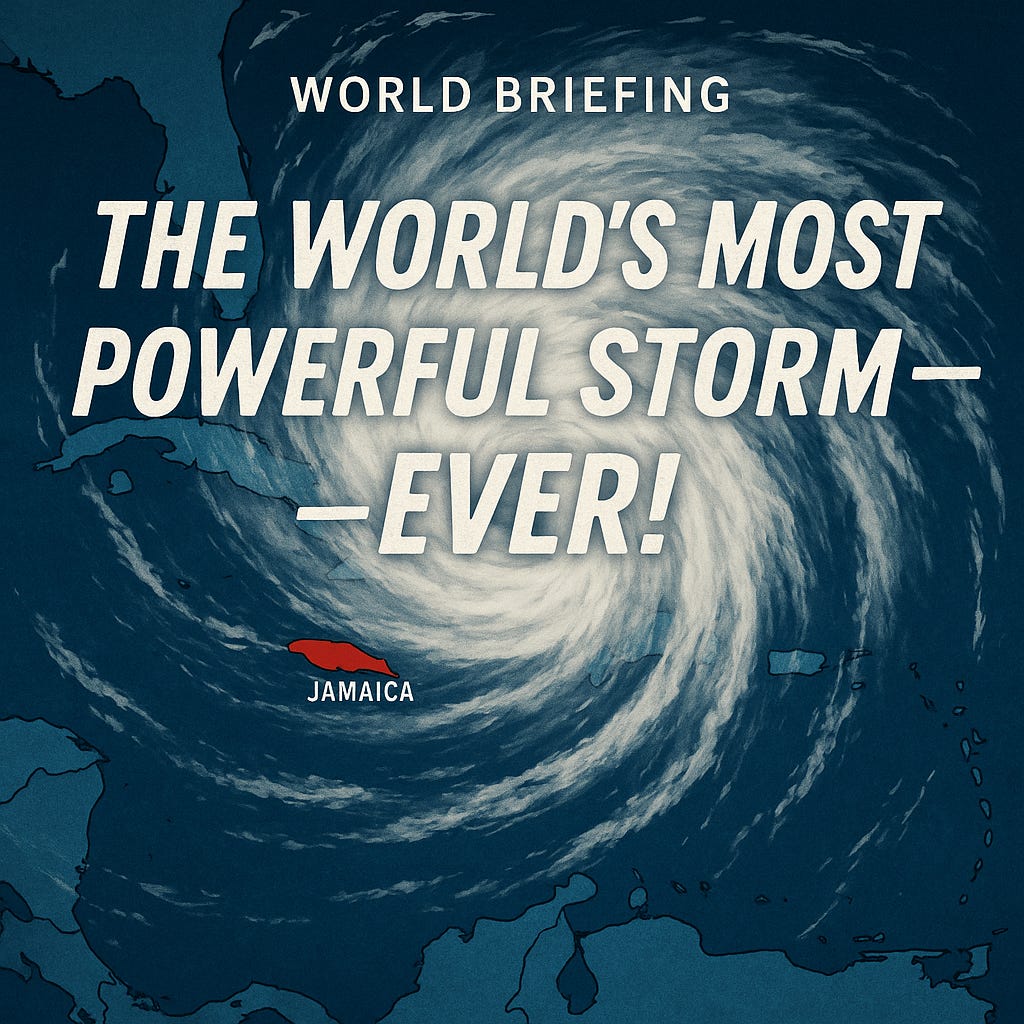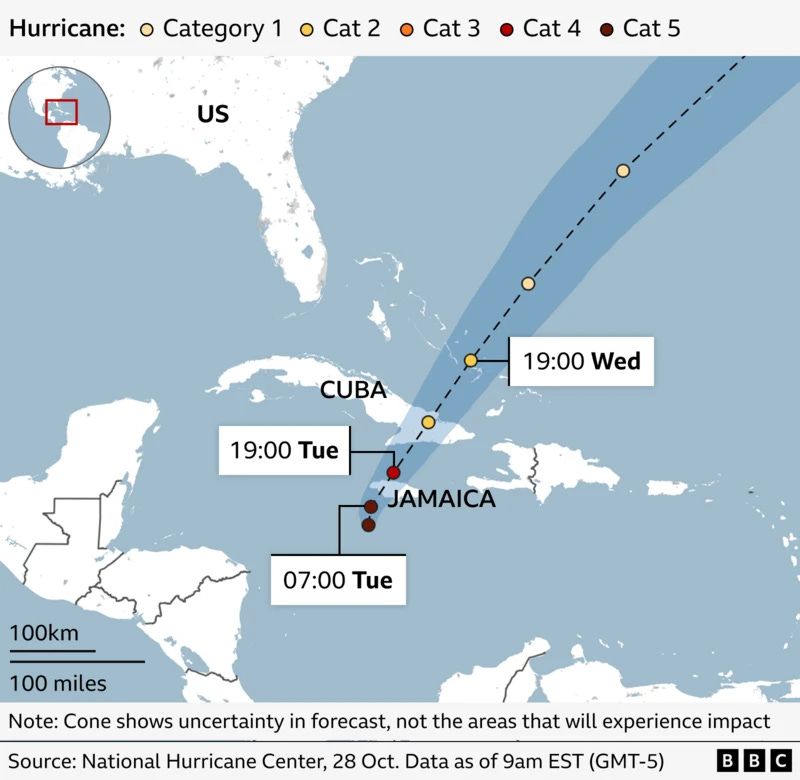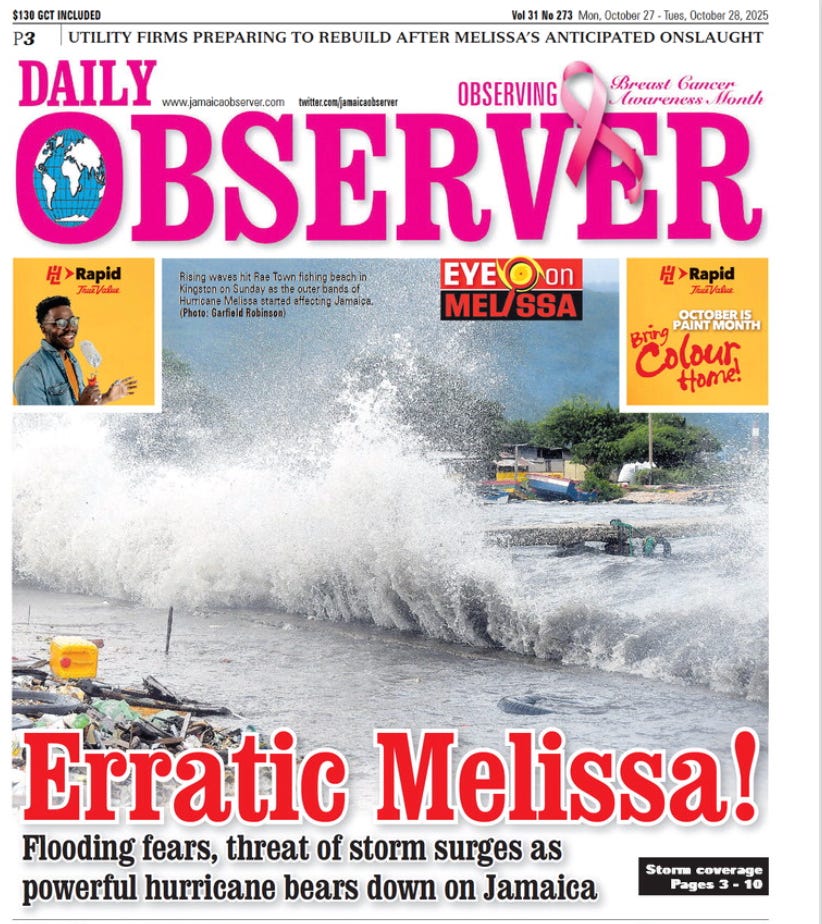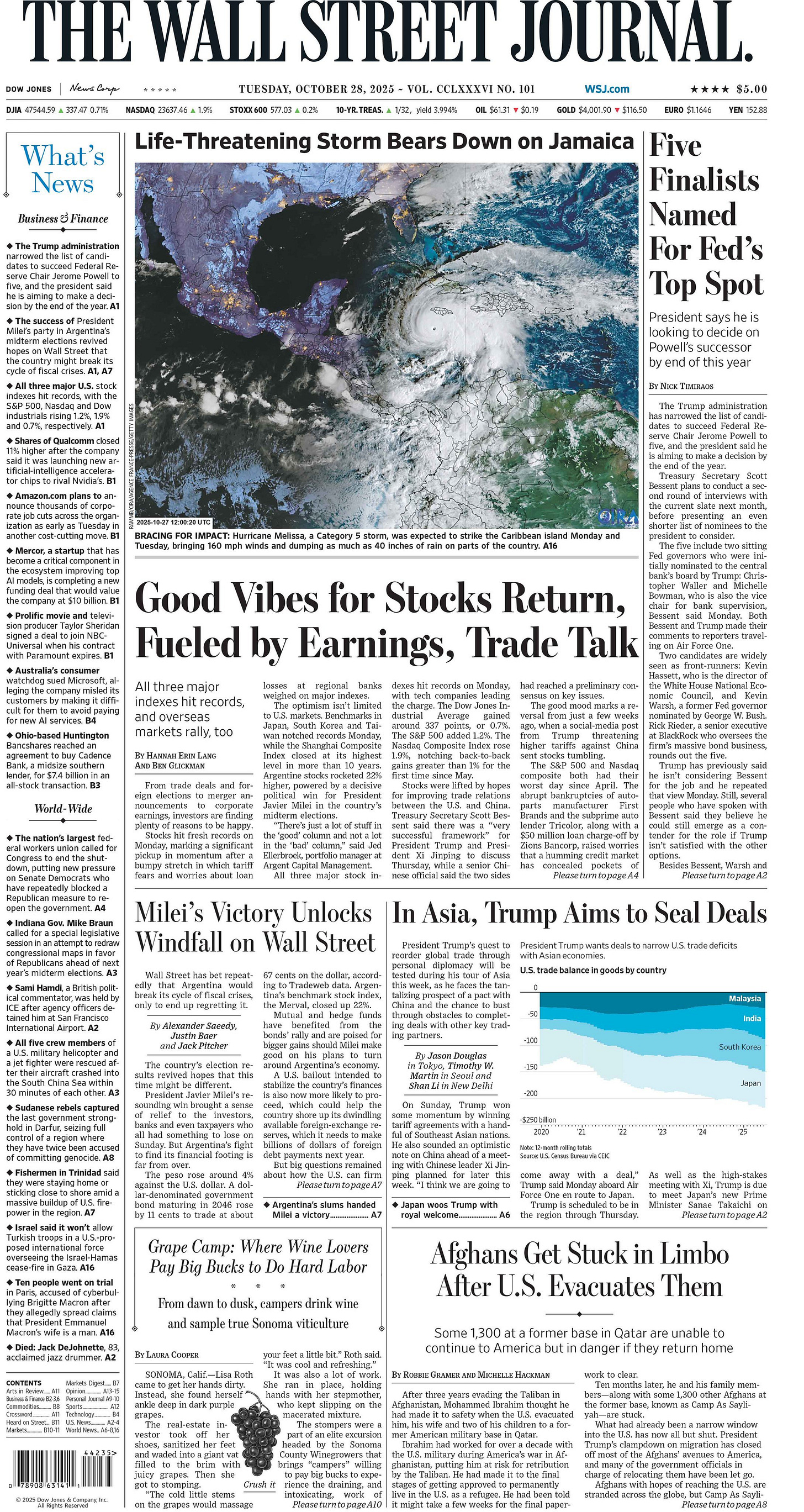The World’s Most Powerful Storm — Ever!
As Jamaica braces for a catastrophic Category 5 hurricane named Melissa, the rest of the world watches a preview of the climate chaos to come.
This week, the Caribbean stares down nature’s full fury. Hurricane Melissa, branded the “storm of the century,” is about to rip through Jamaica — a paradise suddenly on the frontlines of climate collapse. Entire forests will be stripped bare, coastlines redrawn, and lives uprooted. Yet, beyond the swirling winds and storm surge lies a quieter disaster: the slow, unstoppable displacement of millions. As global leaders bicker and delay, the number of climate refugees is set to swell to 1.2 billion by 2050. In today’s World Briefing, I connect the dots between Melissa’s devastation, rising seas from Miami to Manila, and a political class still pretending the tide isn’t rising.
If you value this kind of independent reporting — connecting the local to the global, the human to the geopolitical — consider upgrading to a paid subscription or supporting my work via Patreon or PayPal. It helps me stay on the road, telling these stories where they most need to be told.
Hurricane Melissa will be the “storm of the century” for Jamaica and is expected to cause a “catastrophic situation”, an official from the World Meteorological Organization (WMO) says.
“It’s a catastrophic situation expected in Jamaica,” the WMO’s tropical cyclone specialist Anne-Claire Fontan told reporters.
“For Jamaica, it will be the storm of the century for sure.” “This is a frightening situation for Jamaica,” the country’s Minister of Water, Environment and Climate Change tells the BBC World Service’s Newsday programme. Matthew Samuda says that 70% of the population lives within 5km (3.1 miles) of the sea.
Current status (as of 0921 BST): The eye wall is still to the south of Jamaica and much of the island is already under tropical storm conditions. The storm is very slow moving at only 2mph (3.2km/h) in a north-easterly direction. Now that it has turned northwards, it could speed up a little. The current sustained wind speeds are 175mph (282km/h) with higher gusts. It is an extremely dangerous category five hurricane. It’s the strongest storm on Earth so far this year in terms of wind speeds and central pressure, which is currently just 901 millibars. Landfall is expected later today in Jamaica and catastrophic and life-threatening hurricane-force winds are expected to begin this morning. There will be another 15 to 30 inches of rainfall for Jamaica with a storm surge of up to 13ft near landfall on the south coast with large and destructive waves. On the north-west coast, near Montego Bay, there could be a 2ft to 4ft storm surge. We are expecting landslides and catastrophic flooding. For Haiti, tropical storm conditions will begin later today too, with 6-12in of rainfall. The storm will move northwards very slowly bringing further rain and will then make landfall again in south-eastern Cuba, still as a major hurricane. Swells generated by Melissa are expected to affect portions of Hispaniola, Jamaica, eastern Cuba, and the Cayman Islands during the next several days, likely causing life-threatening surf and rip current conditions. These swells will reach the Bahamas, the Turks and Caicos Islands, and Bermuda later this week - BBC
This will be an unprecedented event in Jamaica…. Even if any structures survive, the landscape will be altered. Native trees will be decimated. Forests will be wiped bare. Only shredded vegetation will be left standing. It’ll take years for the landscape to heal - Matthew Cappucci of MyRadar
There could be 1.2 billion climate refugees by 2050. Extreme weather, rising temperatures and damaged ecosystems are threatening the lives of millions of climate refugees. An annual average of 21.5 million people were forcibly displaced each year by weather-related events – such as floods, storms, wildfires and droughts – between 2008 and 2016, according to the International Displacement Monitoring Centre. This figure reached a record 32.6 million in 2022. The IEP, an international thinktank, expects this number to surge. It predicts that 1.2 billion people could be displaced globally by 2050 due to rise in extreme weather and natural disasters. It is important to acknowledge that extreme weather and shifts in climate patterns do not just pose an immediate threat to people and infrastructure, they are also a longer-term danger that can slowly destabilize societies and economies, says Amar Rahman, Global Head of Climate and Sustainability Solutions at Zurich Resilience Solutions. Take for instance sea-level rise: by 2100, up to 410 million people will be living in areas less than 2 meters above sea level and at risk from sea level rises. Around the world, people are now routinely fleeing their homes to escape the effects of global warming, Columbia Magazine reports. In the African Sahel, a semi-arid region that sits south of the Sahara, altered rainfall patterns are causing farmers to throw down their tools and seek refuge in cities. In Honduras, Nicaragua, and El Salvador, prolonged droughts are killing crops and prompting impoverished families to set out in search of more fertile ground. In Southeast Asia, the rising sea is inundating rice paddies, forcing farmers to quit their livelihoods and retreat inland. Some studies have indicated that tens of millions of Americans could be uprooted by global warming this century, says Columbia geographer Alex de Sherbinin. And already, U.S. homebuyers are starting to avoid entire states because of their vulnerability to wildfires, extreme heat, and windstorms, says Jeremy Porter, a sociologist who teaches at Columbia’s Mailman School of Public Health and at CUNY. Property owners near water need to prepare themselves for the collapse of the waterfront property bubble, which will inevitably come. What will be one of the triggers to cause mass panic, I asked in an OpEd for CNN Opinion way back in 2018? The former mayor of Coral Gables, James Cason, offers a stark scenario: when water levels in that tony community rise to the point where the masts of sailboats are unable to pass under its main bridge, that is when people will “suddenly see their property values go down because they can no longer get a boat out. So that will be one of the first indicators (of sea level rise) and a wake-up call for people.”
National and local leaders appear to be sleepwalking toward climate catastrophe. Based on my own exchanges over the years with municipal mayors from both inland and coastal jurisdictions, my sense is that few view it as a top priority…..In short: if you’re a young to middle-aged homeowner near water in South Florida, there is a chance that your property will be under water by the time you are a senior - or more likely when the time comes to sign the title over to little Jane or Johnny - Michael Bociurkiw on CNN Opinion
Recorded from Miami Beach in November 2020, just after Tropical Storm Eta swept through. Some areas saw over 13 inches of rain and a powerful storm surge along the coast. There’s broad scientific consensus that climate change is driving increasingly extreme weather — from worsening floods to more destructive hurricanes.
A small insurer headquartered in New Zealand, backstopped by some of the world’s biggest reinsurance firms - Maritime Mutual - has helped in the trade of tens of billions of dollars of Iranian and Russian oil by providing vessels skirting Western sanctions with the insurance they need to enter ports, according to a Reuters review of thousands of shipping and insurance records, hundreds of oil trades and sanctions designations, and interviews with more than two dozen people with knowledge of the company. The insurer is run by 75-year-old Briton Paul Rankin and family members. For more than two decades, it has insured everything from tugboats to ferries and cargo ships. Many of those vessels belong to what’s known in shipping as the shadow fleet – the tankers that transport sanctioned cargoes from countries such as Iran, Russia and Venezuela, concealing their trade with fake locations, documents and names. Maritime Mutual’s insurance coverage has played a crucial role in helping this dark fleet – as it’s also known – to operate despite sanctions designed to prevent Iran from raising money for anti-Western militias in the Middle East and to drain Russia’s war chest for the conflict in Ukraine. Reuters reporting reveals that the company, whose main business Maritime Mutual Insurance Association (MMIA) is based in a dark grey office building in Auckland, has insured at some point almost one in six of the shadow fleet tankers that have been sanctioned by Western governments, such as the United States, European Union and Britain. That makes it one of the “big power players” in the industry, said David Tannenbaum, director of sanctions consultancy Blackstone Compliance Services and a former U.S. Treasury sanctions specialist, commenting on Reuters’ findings. “The numbers are larger than a lot of the dark fleet actors we follow that are majors in their business.” Reuters and shipping publication Lloyd’s List have previously reported that Maritime Mutual covered a handful of tankers that have evaded sanctions, and disclosed some details of its ownership and corporate structure. This report is the first to document the scale of the shadow fleet’s use of Maritime Mutual and the major Western companies that support the firm by providing the reinsurance it needs to help cover potentially huge payouts. New Zealand – working with partners including Australia, Britain and the United States – is investigating Maritime Mutual over their concerns it may have enabled the violation of sanctions and failed to meet its obligations to deter money laundering and terrorism financing, according to a person with direct knowledge of the matter. The investigation hasn’t been previously reported. In a statement to Reuters, Maritime Mutual said it “categorically denies” engaging in conduct that breached any applicable international sanctions. It said it maintains a “zero-tolerance policy” on sanction breaches and operates under “rigorous compliance standards designed to ensure full adherence to all applicable laws and regulations”. - Reuters
Hundreds of Central Asians have been killed or are missing since Russia launched its full-scale invasion of Ukraine in 2022, according to the I Want To Live project, which regularly updates its list. That includes over 400 Tajiks, nearly 300 Kazakhs, over 100 Uzbeks, and dozens of Turkmen and Kyrgyz. Thousands of men from Central Asia are believed to have joined Russian forces in Ukraine. Some were lured by offers of lucrative jobs. Others, mainly convicts and detainees, have been forced to join the Russian military. The exact number of Central Asians who have fought in Ukraine is unknown. The I Want To Live project estimates that at least 3,000 men have gone to fight in Ukraine. The project said the real figure is likely to be much higher. The Ukrainian project said its data comes from battlefield reports, prisoner interrogations, and appeals from families searching for their missing loved ones. RFE/RL could not independently verify the names or figures published by the project. Experts say poverty and a lack of job opportunities in Central Asia as well as the success of Russian propaganda are the main factors driving Central Asians to join Russia’s war - RFE/RL
Amazon is planning to cut as many as 30,000 corporate jobs beginning on Tuesday, as the company pares expenses and compensates for over-hiring during the peak demand of the pandemic, according to three people familiar with the matter. The figure represents a small percentage of Amazon’s 1.55 million total employees, but nearly 10% of its roughly 350,000 corporate employees. This would mark Amazon’s largest job cut since late 2022, when it started to eliminate around 27,000 positions. Amazon has been trimming smaller numbers of jobs over the past two years across multiple divisions, including devices, communications and podcasting. The cuts beginning this week may affect a variety of divisions, including human resources, known as People Experience and Technology or PXT; operations, devices and services; and Amazon Web Services, the people said - Reuters
Saudi Arabia is set to welcome up to 130 million tourists set to spend an estimated 300 billion riyals ($80 billion) this year, as the industry rapidly expands after barely existing just six years ago, the country’s tourism minister said in an interview. The new figures put Saudi well on track to meet its 2030 goals of 150 million tourist trips annually, which includes domestic travelers, Ahmed Al Khateeb, the minister responsible for the industry, told Semafor. The kingdom is “not slowing down” investments into tourism infrastructure despite the government “reprioritizing” some of its spending commitments amid a period of low oil prices, he added. Tourism in Saudi Arabia is “growing faster than any other G20 country, and I think that will continue for the next few years until we get our fair share.” The country had 116 million tourist visits last year, including domestic and international travel, with spending totaling 284 billion riyals. Of the former, international arrivals accounted for 30 million, and have persistently grown at a rate in the double digits, Al Khateeb said - Semafor







